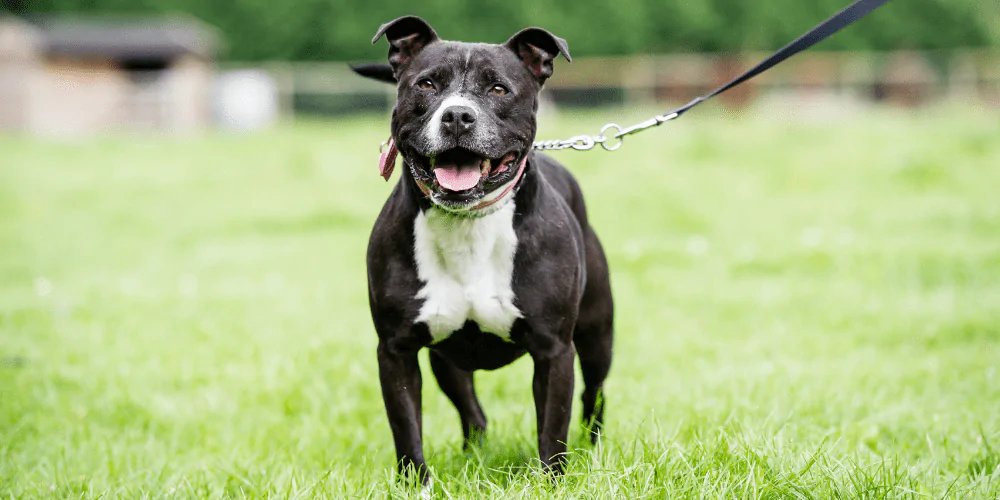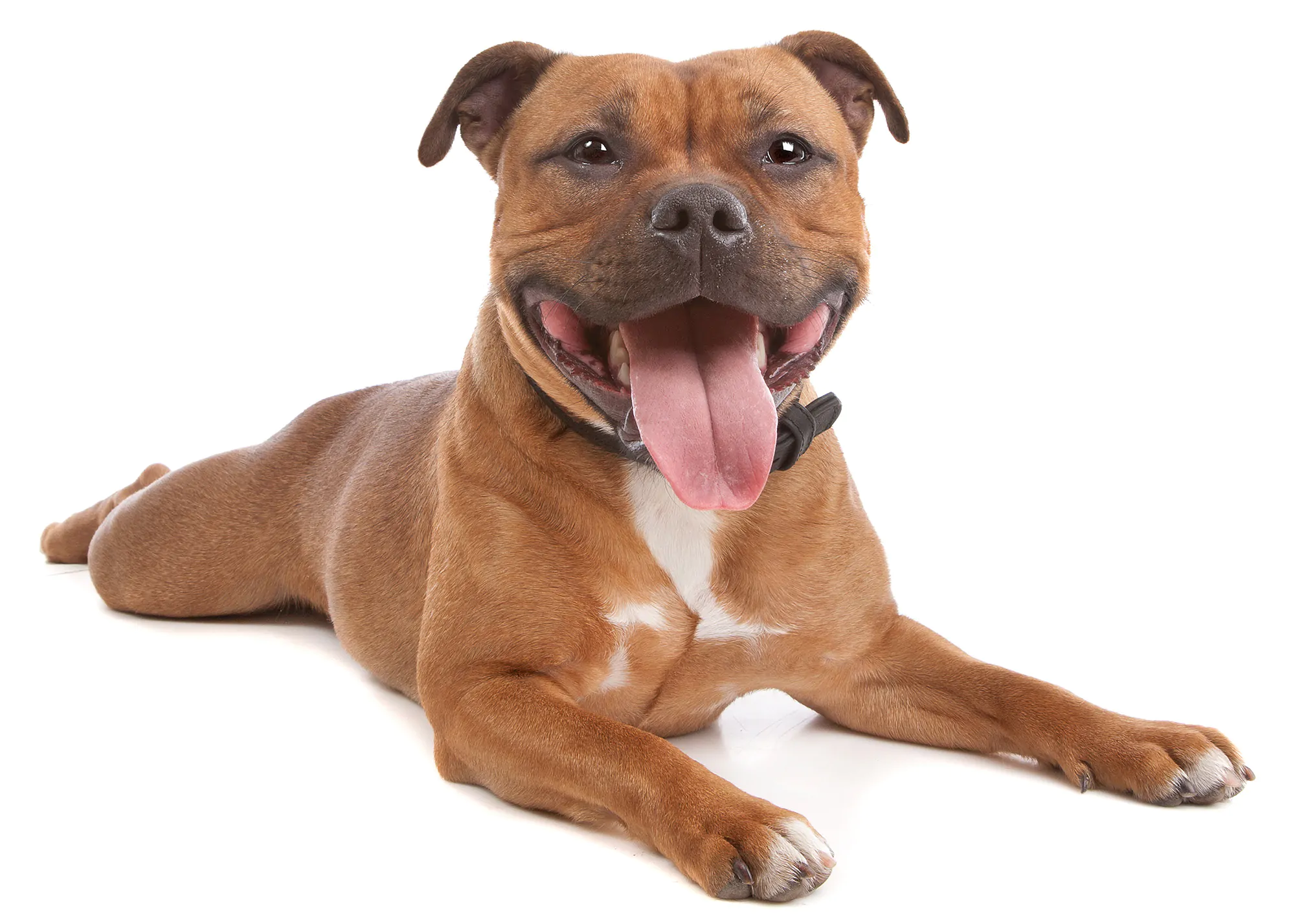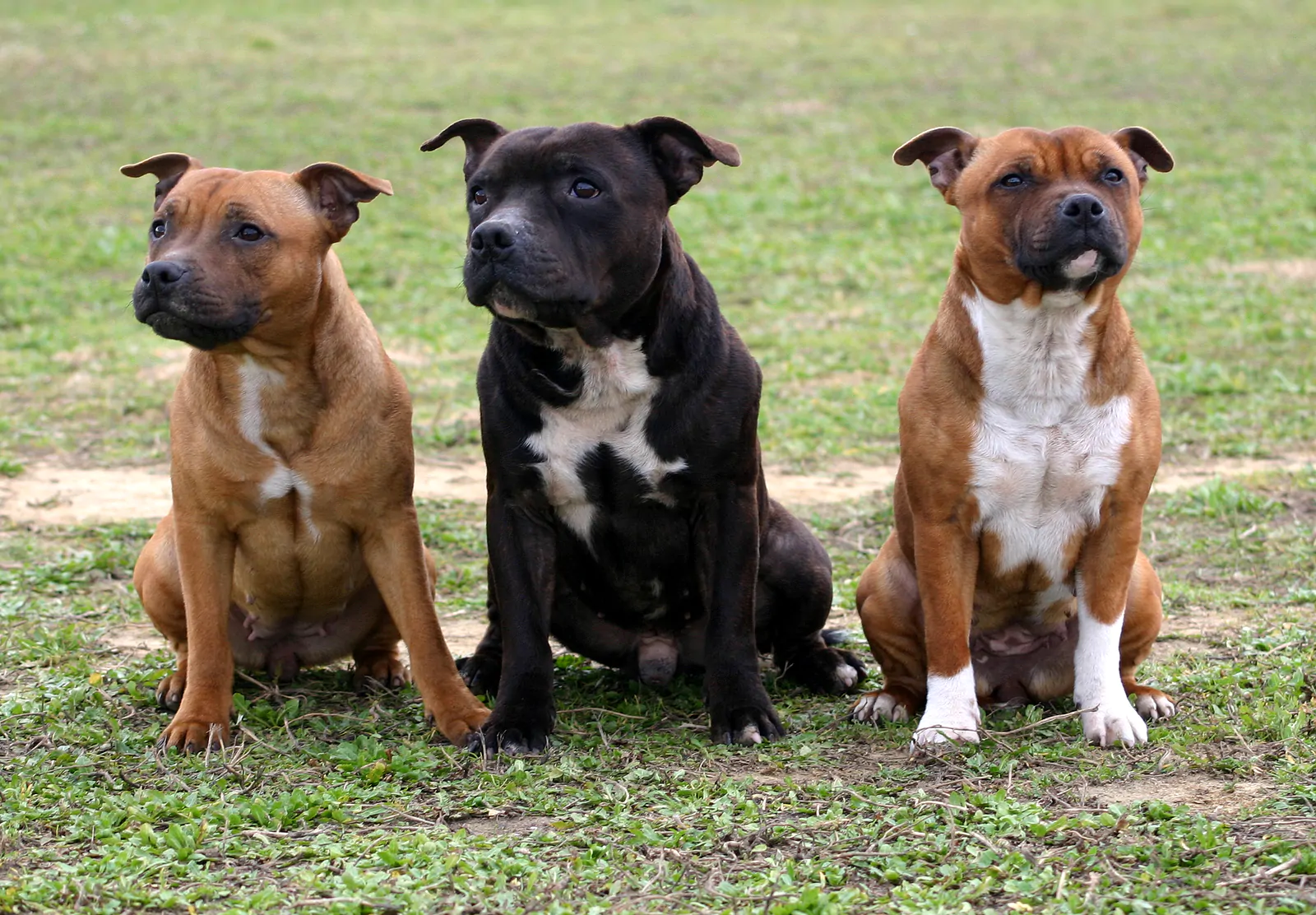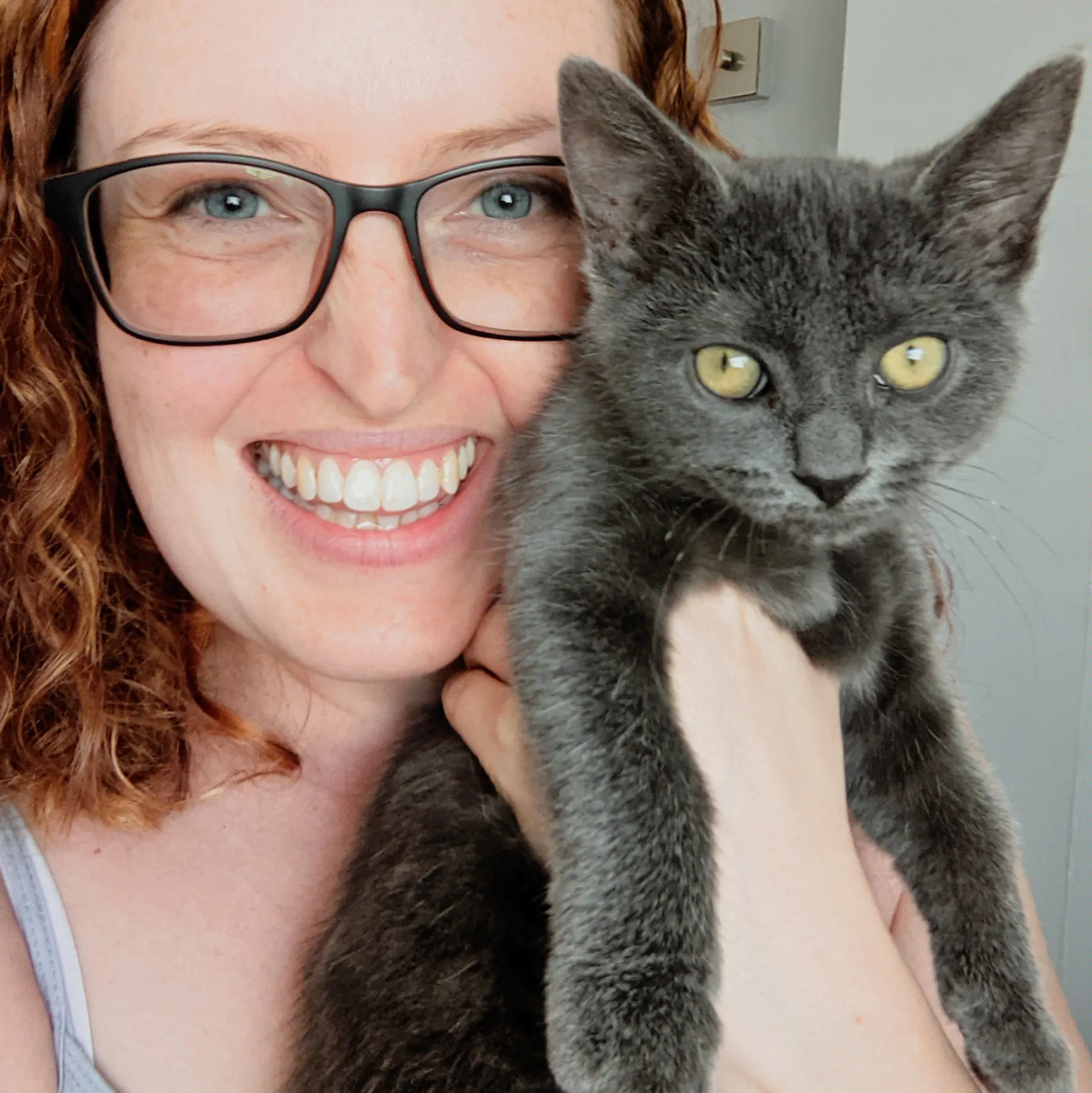Covers your pet up to the chosen vet fee limit if they have a dental accident or injury. Always be sure to take your pet for annual dental check-ups, and follow your vet’s advice.
Staffordshire Bull Terriers are tough on the outside, soft on the inside. They’re affectionate, love their humans, and are a great family dog. As a muscular breed, you’ll need to give them plenty of exercise, and also a good mental workout for their big old brains.


A guide to owning a Staffordshire Bull Terrier
The Staffordshire Bull Terrier, affectionately known as the ‘Staffie’, is one of the UK’s most beloved dog breeds. They’re well-known for their loyalty, courage and big hearts. Compact and powerful, the Staffie has an endless enthusiasm for life and a remarkable love for people, particularly children. Their intelligence and energy make them fun to train and a joy to be around, though you’ll need to give them firm, positive guidance and plenty of exercise.
Despite their muscular build and strong appearance, Staffies are affectionate, people-loving companions who thrive on human interaction. Due to the breed’s history of being used for fighting and animal baiting, Staffies are sometimes viewed as dangerous and aggressive dogs. This unfair reputation occasionally precedes them still, but in truth, humans are to blame for this – not the dogs themselves. Staffordshire Bull Terriers are actually one of the most affectionate, loving breeds going.
Like any dog, Staffordshire Bull Terriers have their own needs and quirks. Here we’ll take a more detailed look into their personality, common health issues, grooming requirements and all the details you need to know.
Are Staffordshire Bull Terriers good family dogs?
Yes, Staffordshire Bull Terriers are well-known for their affectionate and loyal nature, making them excellent family pets. Often referred to as ‘nanny dogs’, they’re terrific with children thanks to their patience and protective instincts. With the right training and socialisation, Staffies form strong bonds with their families and thrive in loving, active homes.


Staffordshire Bull Terrier size and appearance
The Staffordshire Bull Terrier is a medium-sized, muscular dog with a strong yet compact build. They typically stand 36-41 cm tall at the shoulder and weigh between 11-17 kg. They have a broad head, short muzzle and expressive eyes.
Their short, smooth coat comes in a variety of colours, often with markings, including:
- Brindle (dark, irregular stripes on a lighter base coat)
- Black
- Blue (grey)
- Red
- Fawn (yellowish tan)
- White
What was the Staffordshire Bull Terrier bred for?
The Staffordshire Bull Terrier was originally bred in 19th-century England for bull-baiting and later as a fighting dog, combining the strength of Bulldogs with the agility of terriers. When those practices were thankfully outlawed, breeders focused on developing the Staffie’s loyal and gentle temperament, transforming the breed into a devoted family companion.
Nowadays they’re known for their courage, affection and adaptability, excelling as both loyal pets and therapy dogs.


What is a Staffordshire Bull Terrier’s temperament?
The Staffordshire Bull Terrier’s temperament is:
- Tough exterior, soft centre: Courageous and confident, yet very affectionate with family
- People person: Highly loyal and people-orientated
- Full of beans: Playful and energetic
- Smart Alec: Intelligent and eager to please
- Sensitive: Thrives on positive attention
Can Staffordshire Bull Terriers be left alone?
Staffordshire Bull Terriers are very people-orientated. This means they generally don’t like being left alone for long periods. They thrive on companionship and can become anxious, bored or even destructive if left by themselves too often.
Early training to build independence and short, gradual separations can also make time alone easier for them to handle.
Bear in mind that no dog should be left alone for more than four hours. If you do need to leave them for a period of time, be sure they have comforts such as toys and a comfortable spot where they can retreat. Background sounds can help too, like leaving the radio on.
If you do need to leave them for a longer duration, ask someone to check in on them so they can have some company, exercise and an opportunity to go to the toilet.


How much exercise does a Staffordshire Bull Terrier need?
Staffies are active, muscular dogs that need at least one to two hours of exercise each day. They love brisk walks, games of fetch, agility training and time spent playing with their humans.
Mental stimulation is just as important, as their intelligence and energy can lead to boredom if not properly channelled.
Can Staffordshire Bull Terriers swim?
Some Staffordshire Bull Terriers enjoy swimming, but not all are natural swimmers due to their solid build and short legs. If you choose to introduce your Staffie to water, do it with baby steps, and always under supervision. You could also use a dog life jacket to help them stay safe and confident in deeper water.


Our expert says…
“While Staffordshire Bull Terriers are generally healthy dogs, they are prone to a few conditions. I have seen dozens of Staffies over the years with lumps and bumps, many of which have turned out to be mast cell tumours. Mast cell tumors can vary in severity, with some only causing problems locally and others spreading elsewhere in the body. Treatment will depend on how aggressive the mass is, but surgery with wide margins is usually required to ensure all of the cancer cells are removed. Chemotherapy may also be needed in some cases.
“Skin allergies are frequently diagnosed in Staffies, with many requiring ongoing management of their condition. This may involve medication to reduce inflammation and itchiness, diet changes, and topical treatments like shampoos or ear drops.
“Demodectic mange is also a common problem in this breed. Demodex is a small, harmless, cigar-shaped mite found in low numbers in the skin of many healthy dogs. But in animals with compromised or underdeveloped immune systems, like puppies, mite numbers can rise and cause issues. Staffordshire Bull Terriers, Pugs and French Bulldogs seem more predisposed to this issue than other breeds. One Staffy puppy I treated had multiple patches of fur loss, so I took some samples and found mites under the microscope. He responded well to some prescription anti-parasite treatment, and his fur soon started to re-grow.”
Dr Rebecca MacMillan BVetMed BSAVA PGCertSAM MRCVS


How long do Staffordshire Bull Terriers live?
A healthy Staffordshire Bull Terrier typically lives between 12 and 14 years. With a balanced diet, regular exercise and regular check-ups at the vet, many Staffies remain strong and active well into their senior years.
What are the common health issues for a Staffordshire Bull Terrier?
Staffies are generally healthy, but they can be prone to certain hereditary conditions. Hip and elbow dysplasia are potential issues on account of their muscular structure. Skin allergies are also fairly common, often triggered by food or environmental factors.
They may also be susceptible to cataracts and hereditary eye diseases, so regular eye tests are recommended. Another condition seen in the breed is L-2-hydroxyglutaric aciduria (L-2HGA), a rare neurological disorder that reputable breeders test for.
The best way to manage potential health issues is to make sure they maintain a healthy weight, feed them good-quality food and take them to the vet for regular check-ups.


Staffordshire Bull Terrier grooming and hygiene
Here are a few ways to keep your Staffordshire Bull Terrier looking spick and span:
- Brush their coat weekly to get rid of loose hair and maintain its shine.
- Bathe them occasionally using a gentle dog shampoo.
- Wipe their face and check ears regularly for dirt or wax build-up.
- Brush their teeth several times a week to prevent tartar forming.
- Keep an eye on their nails. They’ll need a trim now and again to avoid overgrowth and discomfort. If you’re not confident doing this, take them to a groomer regularly.
Do Staffordshire Bull Terriers shed?
Yes, Staffies do shed, but only lightly. They’ll shed a little more during the change of season in spring and autumn. But generally speaking, their short, sleek coat makes shedding easy to manage with regular brushing.
Are Staffordshire Bull Terriers hypoallergenic?
No, Staffordshire Bull Terriers aren’t considered hypoallergenic. Although their short coat produces less hair than some breeds, they still shed dander (dead skin), which can trigger reactions in those sensitive to allergies.
It’s also worth noting that no dogs are truly hypoallergenic. If you or a member of your family are at risk of being allergic, spend a bit of time with the dog you’re thinking of buying or rehoming before you commit.


How to train a Staffordshire Bull Terrier
Staffordshire Bull Terriers are intelligent and eager, which is great as far as training’s concerned. But, of course, it depends on the individual. Some Staffies can have a stubborn streak. And in all cases, the onus is on you to be firm, consistent and patient.
Here are a few tips:
- Start socialisation early. This’ll help build confidence around people and other dogs.
- Positive reinforcement is key. Encourage your Staffie’s progress with praise, affection and treats. This is also good for bonding with your pup.
- Keep training sessions fun and varied to hold their attention.
- Be firm but kind. They respond best to patient, consistent handling.
- Provide plenty of mental stimulation through obedience, agility and problem-solving activities.


What insurance do I need for my Staffordshire Bull Terrier?
The level of dog insurance to get for your Staffordshire Bull Terrier will usually come down to your budget and circumstances. To find out exactly what you’re getting for your money, read our guide to whether pet insurance is worth it.
At Petgevity, we think all dogs deserve the most comprehensive level of cover as possible. This is why we only sell different types of lifetime cover. We could also cover your Staffordshire Bull Terrier for any pre-existing conditions they may have with our Lifetime Plus policy, subject to acceptance*.


Guides and advice from experts
Our expert vets and behaviourists have great pointers to help keep your pet happy and healthy.

If your dog gets ill or has an accident, you want to give them the best care possible. Let’s take a look at why having pet insurance is important for your pooch.

How to choose the best pet insurance for my pet
We explain the top things you may want to think about when it comes to researching pet insurance policies, including how you can compare pet insurance.

What is lifetime pet insurance?
We’re saying farewell to all of the confusion around lifetime pet insurance. Join us as we explore what it is and how it works.
What’s included in your dog cover
Choosing Petgevity to protect your dog gives you more than just vet fee cover. Here's what you get from our policy.
Dental accident
Covers your pet up to the chosen vet fee limit if they have a dental accident or injury. Always be sure to take your pet for annual dental check-ups, and follow your vet’s advice.
More info
Covers your pet up to the chosen vet fee limit if they have a dental accident or injury. Always be sure to take your pet for annual dental check-ups, and follow your vet’s advice.
Behavioural treatment
Get expert help with your pet’s mental and emotional wellbeing, as advised by your vet. Cover up to your chosen vet fee amount or the cost of up to 12 sessions, whichever is lower (Lifetime Plus); or up to £1,000 (Lifetime).
More info
Get expert help with your pet’s mental and emotional wellbeing, as advised by your vet. Cover up to your chosen vet fee amount or the cost of up to 12 sessions, whichever is lower (Lifetime Plus); or up to £1,000 (Lifetime).
Complementary therapy
As advised by your vet, this covers alternative treatments like acupuncture or hydrotherapy. Cover up to your chosen vet fee amount (Lifetime Plus); or up to chosen vet fee amount or £1,500, whichever is lower (Lifetime).
More info
As advised by your vet, this covers alternative treatments like acupuncture or hydrotherapy. Cover up to your chosen vet fee amount (Lifetime Plus); or up to chosen vet fee amount or £1,500, whichever is lower (Lifetime).
Emergency care
If you can’t look after your pet due to an emergency, such as an unplanned hospital visit, this covers you for up to £1,500 (Lifetime Plus) in minding costs.
More info
If you can’t look after your pet due to an emergency, such as an unplanned hospital visit, this covers you for up to £1,500 (Lifetime Plus) in minding costs.
Third-party liability for dogs
Covers you for legal costs if your dog causes injury to somebody or their pet, or causes loss or damage to someone’s property. Protects you for up to £2 million in a legal action.
More info
Covers you for legal costs if your dog causes injury to somebody or their pet, or causes loss or damage to someone’s property. Protects you for up to £2 million in a legal action.
Choice of optional extras
Need extra protection? Choose from several optional extras to cover your pet’s needs, including dental illness, or cover if your pet is stolen or lost.
More info
Need extra protection? Choose from several optional extras to cover your pet’s needs, including dental illness, or cover if your pet is stolen or lost.
Dental accident
More infoBehavioural treatment
More infoGet expert help with your pet’s mental and emotional wellbeing, as advised by your vet. Cover up to your chosen vet fee amount or the cost of up to 12 sessions, whichever is lower (Lifetime Plus); or up to £1,000 (Lifetime).
Complementary therapy
More infoAs advised by your vet, this covers alternative treatments like acupuncture or hydrotherapy. Cover up to your chosen vet fee amount (Lifetime Plus); or up to chosen vet fee amount or £1,500, whichever is lower (Lifetime).
Emergency care
More infoIf you can’t look after your pet due to an emergency, such as an unplanned hospital visit, this covers you for up to £1,500 (Lifetime Plus) in minding costs.
Third-party liability for dogs
More infoCovers you for legal costs if your dog causes injury to somebody or their pet, or causes loss or damage to someone’s property. Protects you for up to £2 million in a legal action.
Choice of optional extras
More infoNeed extra protection? Choose from several optional extras to cover your pet’s needs, including dental illness, or cover if your pet is stolen or lost.
*Cover for pre-existing medical conditions is subject to acceptance. They will not be covered unless you have declared them and they are shown on your Confirmation of Cover.

